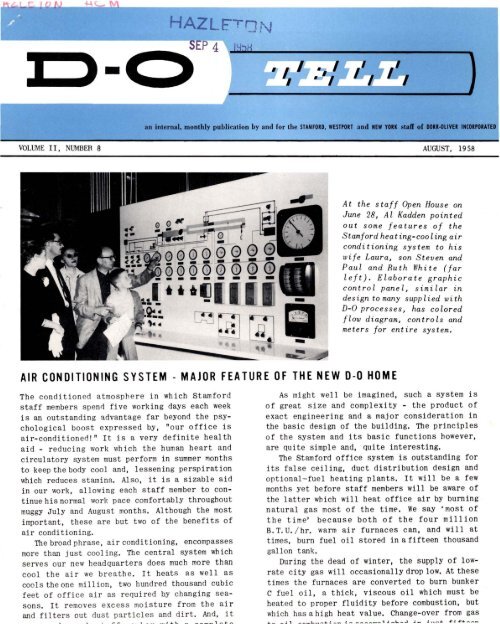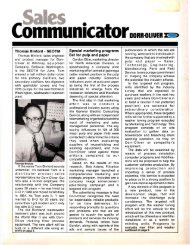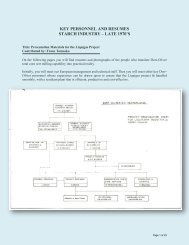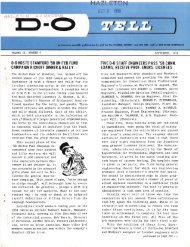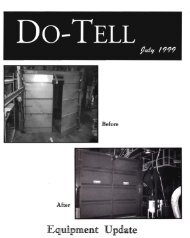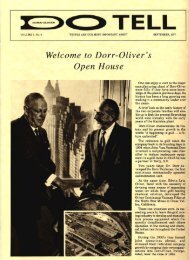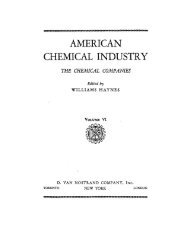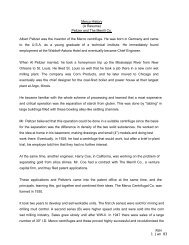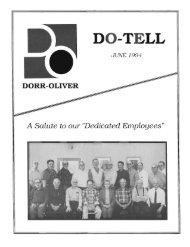O~P4 - Dorr-Oliver Alumni
O~P4 - Dorr-Oliver Alumni
O~P4 - Dorr-Oliver Alumni
Create successful ePaper yourself
Turn your PDF publications into a flip-book with our unique Google optimized e-Paper software.
_ _ _ _<br />
I<br />
) -<br />
<strong>O~P4</strong><br />
HAZLFTQ;'J<br />
J~bH<br />
)<br />
an internal, monthly publication by and for the STAMFORD, WESTPORT and N£W YOII atal of DOII-OLlYER INCORPORATED<br />
VOLUME II, NUMBER 8 AUGUST, 1958<br />
At the staff Open House on<br />
June 28, Al Kadden pointed<br />
out some featu res of the<br />
Stamford heat ing-coo ling air<br />
conditioning system to his<br />
wife Laura, son Steven and<br />
Paul and Ruth White (far<br />
left). Elaborate graphic<br />
cont rol panel , similar in<br />
des ign to many supp lied wi th<br />
D-O processes, has colored<br />
flow diagram, cont rol s and<br />
meters for entire system.<br />
AIR CONDITIONING SYSTEM - MAJOR FEATURE OF THE NEW D-O HOME <br />
The conditioned atmosphere in which Stamford<br />
staff members spenri five working days each week<br />
is an outstanding advantage far beyond the psychological<br />
boost expressed by, "our office is<br />
air-conditioned!" It is a very definite health<br />
aid - r ed ucin g work which the human heart and<br />
circulatory system must perform in summer months<br />
to keep the body cool and, lessening perspiration<br />
which reduces stamina. Also, it is a sizable aid<br />
in our work, allowing each staff member to continue<br />
his normal work pace comfortably throughout<br />
muggy July and August months. Although the most<br />
important, these are but two of the benefits of<br />
air conditioning.<br />
The broad phrase, air conditioning, encompasses<br />
more than j ust cooling. The central system which<br />
serves our new headquarters does much more than<br />
cool the air we breathe. It heats as well as<br />
cools the on e million, two hundred thousand cubic<br />
feet of office air as r equired by changing seasons.<br />
It r emove s exc ess mo isture from the air<br />
and filters out dust particles and dirt. And, it<br />
• 1 •• • ~ .. \.. ...... ..... .... ..... , ,... ... '"<br />
As might well be imagined, such a system is<br />
of great size and complexity - the product of<br />
exact engineering and a major consideration in<br />
the basic design of the building. The principles<br />
of the system and its basic functions however,<br />
are quite simple and, Quite interesting.<br />
The Stamford office system is outstanding for<br />
its false ceiling, duct distribution design and<br />
optional- fuel heating plants. It will be a few<br />
months yet before staff members will be aware of<br />
the latter which will heat office air by burning<br />
natural gas most of the time. We say 'most of<br />
the time' because both of the four million<br />
B.T.U. / hr. warm air f urnaces can, and will at<br />
times, burn fuel oil stored in a fifteen thousand<br />
gallon tank.<br />
During the dead of winter, the supply of lowrate<br />
city gas will occasionally drop low. At these<br />
times the furnaces are converted to burn bunker<br />
C fuel oil, a thick , viscous oil which must be<br />
heated to proper fluidity before combustion, but<br />
which has a high heat val ue. Change-over from gas
Jl:lese two w,:,-rm ai r heating furnaces are optionall y fed<br />
wlth fuel 011 or natural gas (note labels on piping).<br />
Fuel oil pil?ing is insulated against loss of heat provided<br />
by Clrculation to furnaces. Control s are automatic.<br />
AIR COND ITIONING continued ...<br />
for economy since both industrial rate natural<br />
gas and bunker C oil are the least expensive<br />
fuels available.<br />
In August, we are understandably not so much<br />
interested in heating as in cooling. Cooling the<br />
office air is accomplished by removing the heat<br />
from it. While the simplicity of that fact may<br />
seem almost ridiculous, it is the basic physical<br />
principle upon which this system and all "air<br />
conditioners" are designed.<br />
Heat from the office air is removed by chilled<br />
water in coils. This is the reverse of the automobile<br />
radiator in which hot water in the radiator<br />
is cooled by a rush of air through its coils.<br />
In our air conditioning system this heat is then<br />
absorbed by a compressed refrigerant gas. From<br />
the gas it is absorbed by circulating water in<br />
the cooling tower outside at the rear of the<br />
building. Heat in this water is dissipated in<br />
the surrounding outside air by means of fans<br />
in the cooling tower.<br />
Understanding how this heat transfer is accomplished<br />
(from one to another of each of the thr ee<br />
closed circuit c irculat i on systems), is best<br />
illustrated by following the seemingly intangible<br />
heat through a complete cycle. Office air is<br />
drawn through five louvered shafts at different<br />
points in the building. It travels down under<br />
the building, through man-sized concrete air<br />
tunnels to the rear of the building. Here it is<br />
drawn by a pair of one hundred horsepower fans<br />
through three hundred and f ifty square feet of<br />
fibre filter blank et which effectively traps<br />
dust, dirt and pollen. Removal of these minute<br />
Filtered air, one hundred and seventy thousand<br />
cubic feet of it per minute, is blown by the fans<br />
over four decks of coils containing chilled<br />
water. Air temperature drops on contact with the<br />
coils and excess moisture, wh ich cannot be contained<br />
in the air at reduced temperature, condenses<br />
and drains off. Cooled , filtered and<br />
de-humidified air recirculates to office areas<br />
through cool air ducts and ceiling-mounted distribution<br />
panels throughout the building. In<br />
Winter, the "dead" air is filtered and sent to<br />
the furnaces for heating rather than over the<br />
coils for cooling. The system has a separate<br />
duct arrangement for warmed air.<br />
~~en the building is being cooled, what happens<br />
to the heat absorbed from the air by the<br />
chilled water coils? The chilled water being<br />
pumped at the rate of nine hundred and fifty<br />
gallons per minute through the chilled water<br />
system i s, of course, warmed in the transfer of<br />
heat. It flows to a huge four hundred and eight<br />
ton centrifugal refrigerating compressor, a Trane<br />
Centravac. Liquified refrigerant gas, Freon II,<br />
absorbes the water' s heat. water, again chilled,<br />
is recirculated to the coils to repeat its heat<br />
absorbing function.<br />
Meanwhile the heated liquid refrigerant changes<br />
to gas at the higher temperature. The Centravac<br />
compresses this gas, which is liquified in the<br />
condenser.<br />
Once again we have the unwanted heat which<br />
must be disposed of. Twelve hundred gallons of<br />
water per minute are circulated from the cooling<br />
tower outside the building to the Centravac condenser.<br />
Here this cooled water picks up the heat<br />
Vol. II, No.8<br />
August, 1958<br />
An inte rnal monthly publ ication for the s t am ford,<br />
westport and New Yo rk staff of <strong>Dorr</strong>-<strong>Oliver</strong> Incorporated<br />
. s t a ff originated news about or of<br />
gene ra l i nterest to D-O TELL readers is welcome<br />
and may be submitted to any Reporte r or to the<br />
Editor. The news deadl ine IS th e 5th of each<br />
mont h.<br />
EDITOR<br />
Joseph IIes, Company ReI ations Dept.<br />
Stamford, Connecticut<br />
REPORTERS<br />
Barbara Bolton<br />
Beatrice Fisher<br />
Edna Gormly<br />
Doris Gostomski<br />
Roberta Jarvis<br />
Grace Mainero<br />
Edna Mae Mead<br />
Palma Orest e<br />
Florence Schwenk<br />
Millie Heft<br />
SPORTS<br />
ART<br />
• 1 .... 1 1 ..... T",hn ~; ttc:
COOLING FLOW DIAGRAM OF SYSTEM <br />
OFFICES<br />
return water<br />
...<br />
..<br />
return water<br />
==COOLI NG===<br />
~ TOWER<br />
HEAT<br />
OUTSIDE<br />
~ AIR<br />
HEAT<br />
chilled water<br />
-...<br />
liquid<br />
cooled water<br />
given off by compressing the gas and r eturns to<br />
the tower. This water is cooled by outside air<br />
pulled through it by fans. It is then recirculated<br />
to pick up more heat of compression from the refrigerant<br />
gas.<br />
Thus, heat in the building's inside air is<br />
finally committed to the outside atmosphere.<br />
Lest this system remind us of a slapstick movie<br />
comic frantically transferring fly paper from<br />
one hand to the other in order to rid himself of<br />
the sticky mess, we must consider the tremendous<br />
task in reducing the temperature of more than a<br />
million cubic feet of air even a few degrees<br />
F'ahrenheit.<br />
The heating-cooling air conditioning system<br />
has a number of special features, all a part of<br />
its overall design. Outside air is drawn in<br />
through louvered vents early on summer mornings<br />
wh en its temperature is less than that in the<br />
building. ,During the hour or so of each July and<br />
August morning when this temperature difference<br />
exists, the building can be cooled while the<br />
actual cooling mechanisms are "free-wheeling".<br />
Another special feature is the locating of the<br />
refrigerant compressdr motor within the unit its<br />
elf, where it is cooled by the refrigerant gas<br />
flowing through it.<br />
The entire system is pneumatically controlled.<br />
Air pressure registers operating conditions<br />
throughout the building on the central control<br />
board and, it opens and closes warm and cool air<br />
dampers as called for by the pneumatic thermostatR.<br />
Again illustrating the versatility of the<br />
overall system these pneumatic controls regulate<br />
winter heating as well as summer cooling. They<br />
regulate the system to cool the south side of<br />
1 '<br />
heat required or degrees heat to be removed.<br />
The building's temperature is meapured by<br />
twelve thermostats located in large "critical"<br />
zones throughout all floors. These units indicate<br />
whether their area heating or cool ing r equirements<br />
have been satisfied on the central control<br />
board and, they open or close dampers within main<br />
air circulation ducts to maintain present temperatures.<br />
A total of 80 other thermostats throughout<br />
the building control smaller areas within<br />
the large critical zones.<br />
What happens if something should go wrong and<br />
create an adverse condition? F'ire from leaking<br />
oil or gas is automaticallY detected. and bS the<br />
same alarm system which handles automatic sprinkler<br />
and fire conditions, it is immediately reported<br />
to the American District System Telegraph<br />
office in Bridgeport. From there alarm goes out<br />
to local fire departments and our Plant Superintendent<br />
is notified. The same alarm system<br />
prevents the building from freezing up on winter<br />
nights by signalling if the inside temperature<br />
drops below 55 0 F. Other ingenious protection<br />
devices watch over other possible hazards no<br />
matter how improbable. A far cry from window fans<br />
and one-room stoves that some of us may recall<br />
from bygone days, the Stamford office air conditioning<br />
system is an engineering masterpiece,<br />
increaSing comfort and health and productivity<br />
as well.<br />
Control of the entire system is the responsibility<br />
of Chris Willumson, Plant Superintendent.<br />
A graduate of marine engineering at New York<br />
State Nautical College, Chris has a wide background<br />
in heating and refrigerating as well as<br />
an exacting knowledge of our system. He served<br />
five years at sea as steam and diesel engineer
JAMES BRUNETTI joined Design Section. Sanitary<br />
Technical Division on August 5 as an Engineering<br />
Technical Clerk. Jim. a graduate of Norwalk High<br />
School. attended St. Francis College in Loretto.<br />
Pa. He lives in Norwalk.<br />
Ove r all view of cooling water circulation system In<br />
air conditioning plant. Refri gerant compressor i s In<br />
backgr oun d of photo.<br />
AIR COND ITIONING cont inued ...<br />
on plant survey. design and construction and.<br />
prior to joining the 0-0 staff this year. was<br />
plant eng ineer with Northam-Warren Corporation<br />
three years.<br />
Residents of Darien. Chris and his wife are<br />
parents of young Douglas Willumson. 15 and<br />
Barbara 12.<br />
... ... ..<br />
As a rule. man is a fool <br />
When it' s hot he wants it cool. <br />
When it· s cool he wants it hot. <br />
Always wanting what is not. <br />
On August 7 JAMES LANGE. 1958 graduate of<br />
Lafayette College. was welcomed to the Engineer<br />
Training Program. Married and the father of one<br />
child. Jim has a B.S. degree in mechanical engineering.<br />
He is also a veteran of the U. S. Marine<br />
Corps and while in school. was student member of<br />
the A.S.M.E. The Langes live on Harding Drive in<br />
Stamford.<br />
BARBARA ANN ,JOHNSON r ejoined Office Services on<br />
July 25 as a messenger. She had been a mail clerk<br />
at Barry PI ace from June. 1956 to November. 1957.<br />
At Westport. the staff welcomed typist ELLEN<br />
WILLIAMS on July 21. A graduate of Staples High<br />
School in Westport. Ell en also attended the<br />
University of Connecticut and Mannes College of<br />
Music.<br />
* ,. ,.<br />
On Saturday. August 16. the Metropolitan Section<br />
of the American Society of Civil Engineers held<br />
their annual picnic in Westport on the 0-0 ~Hll<br />
grounds. Donald E. Schwinn. Easte rn Sanitary<br />
Sales Engineer and junior member of the Society<br />
was chairman of this year's affair,the latest of<br />
several ASCE picnics held at the Mill in past<br />
years.<br />
Approximately fifty members of the Metropolitan<br />
Section. young graduate engineers engaged<br />
in sanitary and structural engineering. enjoyed<br />
water and ground sports at the affair. Ch arl es<br />
A. Knapp. Manager of Eastern Sanitary Sales and<br />
former president of the Metropolitan Section was<br />
among other 0-0 staff members attending.<br />
,. ,.<br />
Happily located but not yet settled in their new<br />
Cape Cod in Fairfield are the H. V. Vecseys. formerly<br />
of Sylvan Knoll. AdvertiSing Assistant at<br />
Stamford and home oymer of little over one month.<br />
Howie is merrily devoting every spare working
LONG AWAITED REUNION IN GERMANY BECOMES REALITY <br />
FRANK ELLE of Pl an t Eng i<br />
neering Div i s ion i s a native<br />
of Thuringi a, now a part of<br />
Russian-domina ted East Ge r<br />
many. Thi s i s his sketch of<br />
the long - awaited return and<br />
reunion with h i s f amily and<br />
friends during hi s r ecent<br />
July vacation as reported by<br />
D-O TELL Repo r ter Bee Fi sher.<br />
" Twenty years ago, in a l i ttle vi llage of the<br />
lovely Thuringian Forest region of Ger many, a<br />
family reunion was held at which t ime I pr om i sed<br />
my par ents that, God willing, my wife and I wo uld<br />
r eturn in s even years t o hel p cel ebrate thei r<br />
gol den wedd ing.<br />
"Th e year 1945 found bot h parents living but<br />
not i n a celebrating mood. Th e r avages of war<br />
we re all around them. Sever al bottles of wine,<br />
r eserved for the anniversary, wer e used i nstead<br />
to help quench the t hirst of Ame r ican G. I. ' s<br />
who were passing t hrou gh t he r egi on.<br />
"On e year later, after s even long years of<br />
Sil ence, and short ly before we wer e allowed t o<br />
communicate with each ot her again, my mot he r<br />
di ed. Lat er, in 1949, when my father' s heal t h<br />
took a t urn for the worst, we started proceedings<br />
to visit him . Continual negotiations wi t h t he<br />
U. S. Department of State; the Russian Embassy at<br />
Wash ington; th e Occupation Forces in Berlin; and<br />
finally with the Fi rst Consul of t he West Ger man<br />
Republic , all f ~ il ed . Bu t with my fathe r' s<br />
death in 1953, any positive r esul t wo ul d have<br />
been empty of meaning.<br />
"In 1956, t he death of my only brother confirmed<br />
my wi fe' s r emar k, "It is l ater t han you<br />
think!" Two years of effort, hope , and despair<br />
followeri until we finally received perm i ssion t o<br />
visit the surviving members of my fam ily. My<br />
purpose i n writing is to relate but one of countless<br />
examples of what has happeneri, at so many<br />
places, to the better world we have been s triving<br />
fo r since World War II. Of our personal exper<br />
iences, it might be of general inter est t o<br />
know that our movements in Eastern Ger many we re<br />
restr icted to the "Bezi rk" (Country) in which my<br />
relatives resi rie . As American citizens, we found<br />
the East Ger man officials polite; but by no means<br />
f riendly.<br />
Mr s . ElI e ' s family of several generations t urn ed out<br />
at Fr ankfo r t Airport to welcome her. These r e l ative s<br />
are West Ge r many residents. Relatives in Russi an<br />
domi n ated Ge r many wer e not allowed to go to t h e<br />
Western airport.<br />
"However , we were soon caught up in the Iives<br />
of frienrls and relatives. Spiessrutenlaufen! <br />
to use their expression of our activities whi ch<br />
means that we ran a continual gamut of questi ons.<br />
Not like the old Spiessrutenlaufen whe re Prussi an<br />
soldiers fo r med a riouble line to prori t heir comrades<br />
with spears (Spiesse) or rods (R uten) as<br />
they walkeri (laufen); or the late r use of t he<br />
wo r d as a chi 10' s game; but me r ely o ur own<br />
Sp i essr utenlaufen. We would star t a vis i t at,<br />
say, 10: 30 in the morning with another scheduled<br />
for e l even a nd a thi rd at twelve. At noo n we<br />
wou l d fi nd ourselves still engageri with our<br />
10:30 friends due to the intensity of qu estions<br />
fired f r om al l sides.<br />
"While rationing of fooristuffs Ylas discontinued<br />
shortl y before our arrival, l ong queues wer e<br />
still fo r mi ng for items like tomat oes, cauli
REUNION IN GERMANY continued •••<br />
now part of the daily requirements of the West<br />
German are priced out of reach for the East German.<br />
And yet, from the border on , and all around<br />
the "Bezirk", public buildings were decorated<br />
with inscribed banners proclaiming the accomplishments<br />
and intentions of the red government. In<br />
our opinion these intentions will remain just<br />
that for a long time to come.<br />
"The distance from Martinroda, Thuringia,<br />
where my sisters live, to Berlin is about 150<br />
miles. Inasmuch as a visit to Berlin was a must,<br />
I found it expedient to travel another 150 miles<br />
farther away into West German territory to make<br />
a tUnI-back plane trip to my destin1.tion instead<br />
of chancing a possible delay or even a denial if<br />
I had elected to use the shorter land route.<br />
"In West Berlin the devastation of the last<br />
war holocaust has been cleared away. Not so in<br />
East Berlin. Here most of the ruins have been<br />
left. And where top stories remain, one sees fairsized<br />
trees growing from some of the roof tops.<br />
After all, thirteen years is a long time for some<br />
trees - even when they sprout in the ruins of<br />
war.<br />
"Today East Germans of the middle and older<br />
age groups are, with some exceptions, firmly set<br />
against the present regime. But, like Hitler before<br />
them, the communists have captivated the<br />
youth in the schools and youth camps where they<br />
are fast becoming imbued with the precepts of<br />
Marx, Engels, and Lenin. With no understanding<br />
of other basic and world realities, the young<br />
continue to strengthen the hand which today rules<br />
the East Germans.<br />
"Scarcely one person to whom we talked, now<br />
believes in the reunion of an East and a West<br />
Germany except through force. But no German in<br />
his right mind - East or West - relishes the<br />
thought of another war. "<br />
WEDDINGS<br />
Congratulations go to GUS PHILLIPS, Design<br />
Section, Sanitary Technical Division, upon the<br />
occasion of his marriage to Miss Donna Liberatore<br />
of New Canaan. The happy couple were wed on<br />
Saturday, August 2.<br />
Gifts of dishes and glassware were presented<br />
to Gus from his many 0-0 friends at a brief office<br />
get-together on Friday afternoon preceding<br />
the wedding. An extra special gi ft was also gi ven<br />
to him at that time - the key to the heavy ball<br />
and chain he had been gallantly dragging about<br />
Before • ••<br />
After ....<br />
BARBARA BOLTON and EDWARD McCARTY, both members<br />
of Design Section, Industrial Technical<br />
Division, were married on Tuesday, August 5 at<br />
the First Congregational Chu rch, Darien. The<br />
unannounced ceremony came as a surprise to the<br />
couple's many 0-0 friends who were unable to<br />
discover their secret. Barbara and Ed were engaged<br />
at Christmas last year. Following the<br />
wedding t hey took a honeymoon-vacation trip to<br />
the Poconos resort area. Best wishes to the<br />
Mccartys for a long and happy life.<br />
'" '" .<br />
"Yes, the U.S. is in bad shape. No other country<br />
is suffering political and economic troubles because<br />
of a surplus of food. No other country has<br />
traffic congestion because so many people own
_<br />
INTEROFFICE SOFTBAll<br />
July 8: Procurement-Est imating over Sanitary<br />
Engineering - 15 to 9. After winning the First<br />
Half Champion&hip with two fine victories over<br />
Financial-Sales and Industrial Engineering, the<br />
Sanitary Team dropped this game to Procurement.<br />
Putting on a powerful display at the plate, Procurement<br />
collected twenty base hits from Dick<br />
Mullins. They scored at least two runs in each<br />
i nning except the first and fifth. Sanitary had<br />
a big fourth inning with four runs. Ernie Bisaillon<br />
hit the only four-bagger in this game which saw<br />
Procurement arise from repeated defeats in the<br />
first half.<br />
July 15: Industrial Engineering over Plant<br />
Engineering - 4 to O. With Industrial hurler<br />
Gene Zanelli fighting off Plant Engineering batters<br />
to a six hit shutout, Industrial capitalized<br />
on opponent errors to win the game. A first of<br />
the season, the shutout is the first of Gene's<br />
career on the mound and marked a happy day for<br />
him. Throwing in the other half of the mound<br />
duel, Tony Zvonkovich allowed one less hit than<br />
Gene but with some trouble behind him in the<br />
field, lost the pitching thriller. Lucky Jack<br />
Corcoran smashed a double for the game's only<br />
extra base hit.<br />
July 17: Sanitary Engineering over Financial<br />
Sales - 12 to 9. In defeating Sales in this game,<br />
Sanitary displayed some of their first half<br />
championship form after defeat by Procurement.<br />
Sanitary jumped off to a four run lead in the<br />
first inning. Sales scored six runs in the third<br />
inning but were effectively checked by Dick<br />
Mullins while Sales' Joe Sheehan continued to<br />
have trouble. No home runs in this game.<br />
July 24: Sanitary Engineering over Plant Engineering<br />
- 8 to 1. Both teams drew blood early<br />
with a Plant Engineering run in the first and a<br />
Sanitary run in the second inning. Then followed<br />
three innings of tense, exciting play. In the<br />
sixth however, Sanitary blew the game wide open<br />
with four runs on four hits as Plant Engineering<br />
weakened. In the top of the seventh, Sanitary<br />
insure~ their win with three additional runs.<br />
July 29: Sanitary Engineering over Industrial<br />
Engineering - 15 to 6. Continuing their winning<br />
ways in a t hird straight victory, Sanitary batters<br />
again proved their great strength at the<br />
plate. Prank Fiorito and Bill Kocis slammed<br />
homers out of sight. Dick Mullins again pitched<br />
a fine game. He seems to be his best against<br />
Industrial who have not been able to win a game<br />
from Sanitary all season.<br />
August 5: Financial-Sales over Plant Engineering<br />
- 19 to 5. Sales scored ten runs in the<br />
seventh inning to sew up the game. Joe Sheehan<br />
looked sharp, holding Plant Engineering to five<br />
runs on eight hits. Joe Marino, subbing on the<br />
mound for Zvonkovich and Kwochka, gave up eleven<br />
bases on balls and hit four batters for a total<br />
of fifteen free tickets to first base - shades<br />
of Howie Vecsey!<br />
August 7: Procurement-Estimat i ng over Industrial<br />
Engineering - 10 to 7. Damon Bush, colorful<br />
and agile, performed two of the best fielding<br />
gems of the year in this hard fought game. Glen<br />
Ekstrom and Joe Carlucci lofted a serve each onto<br />
the roof in left center f i eld for homers.<br />
Pitching for Procurement, Tony Costantino did<br />
well on the mound. In the last of the seventh<br />
i nning and ahead by ten to six, Tony tired a bit<br />
and allowed one run to score. Then with two outs<br />
and two men on base, Don Van Cott drove a hit to<br />
deep left field. Damon Bush, runni ng at the<br />
crack of the bat, climbed up the left field<br />
screen and with his back to the plate made a one<br />
hand overhead stop which is the sensation of the<br />
seasonI As if the beautifully fielded double base<br />
hit wasn't enough, Damon collected four hits in<br />
five trips to the plate. Always a great competitor,<br />
he provides plenty of fire for his team.<br />
STAMFORD CITY LEAGUE GOlf<br />
With the D-O "F" and "D" flight teams at the end<br />
of their schedules the league season is drawing<br />
quickly to a close. For the D-O staff members<br />
who participated this year, it was a really great<br />
season. Dick Attridge and Ed Ivanuskas won 19<br />
• .. _ L. ,.. .%_ .. h,,;,.. a;tJ'ht m~t. ~h Reason.
Ed Ivanuskas careful ly studies 25'<br />
putt which he then successfully<br />
dropped in the cup .<br />
than second rlace for their flight in the forthcoming<br />
playoff match. This is the third year of<br />
league play for the team and second year they<br />
have brought hom e a trophy. Good luck in the<br />
playoff match to both golfers; may they bring<br />
back the first place trophy!<br />
In "D" flight Costantino and Ballo won 16%<br />
and lost 4% points in a total of seven matches.<br />
With this record Tony and your reporter are also<br />
assured of a second place in the flight. Barnes<br />
Engineering is in first place at present but<br />
with two matches remaining to be played. With<br />
luck <strong>Dorr</strong>-<strong>Oliver</strong> could boast two first place<br />
trophies this year. Tony is much improved this<br />
year, dropping from the high eighties to the low<br />
eighties and carding below 85 consistently.<br />
In the "A" flight, EdPataky and your reporter<br />
have a little l ess to s how for their efforts.<br />
Th e record is 7 won and 11 lost with three<br />
Dick Attridge ga zes in amazement at ball he<br />
must play from where it bounced on sprinkler<br />
hose.<br />
Tony Cos tan tino leaves pin<br />
in cup for short putt.<br />
matches remaining to be played. Flight "A" is<br />
the top of the League, represented by the best<br />
golfer s of all Stamford industries.<br />
Last month , in a match which saw the D-O team<br />
win all th r ee points, a best ball of 71 was<br />
carded. Ed had three birdies (one und er par) in<br />
the match . In the many rounds of golf your r e<br />
porter has played at Hubbard Heights with some<br />
of Stamford's best golfers, he has yet to see<br />
anyon e top the Pataky boys on long dri ves from<br />
tee. On the par four, number sixteen hole in<br />
this match, Ed belted his tee shot to within ten<br />
feet of the pin - a distance of three hundred and<br />
twenty yards. Following through , he two-putted<br />
for a birdie three. Last year on two differ ent<br />
occasions, brother Fran Pataky turned the same<br />
trick.<br />
Because teams in this flight are so evenly<br />
matched score-wise, there is still a slim chance<br />
for the D-O "A" duo to finish in the running.<br />
Certainly a clean sweep of first or second places<br />
in all flights the company enters is a goal worth<br />
shooting for.<br />
MEN'S OFFICE GOLF LEAGUE<br />
Momentum in the office league picked up last<br />
month with a sizable number of matches overcoming<br />
the go lfers s low start early in the season. At<br />
the end of the fourth r ou nd of play the Bogeys<br />
have taken over first place with 884 strokes,<br />
seventeen less than their nearest rival, the<br />
Mashies. Th e Divots, Hackers and Birds ar e in<br />
third, fourth and fifth places respectively.<br />
Good scores turned in last month were: 74 <br />
Ed Pata~y; 81 - Bill Ballo; 88 - Tony Costantino<br />
1\ 1 UUF'
Bill Henry and Al Kwi atkowski both broke ninety<br />
recently for the first time with 89' s , Bill<br />
regularly shoots in the low hundreds.<br />
The league regrets the loss of stan Barwikowski<br />
who has been out of play t he past two months wi th<br />
a bone spur on his heel. A potential low eighty<br />
golfer, Stan has been especially missed by his<br />
team,<br />
1958 INTEROFFICE GOLF LEAGUE<br />
Divots Mashies Birds<br />
Ed Pataky Bill Ballo Paul Pellegrini<br />
Gene Zanell i Nestor Sabi Charlie Ar ena<br />
Steve Bak Frank Paternostro Ed Piorkowski<br />
Joe Snyder Pete Hubbard Ed Hiller<br />
Jay Hague Dick Mullins Bi~l Henry<br />
Hackers<br />
Wayne Wiisanen<br />
Al Kwiatkowski<br />
Dick Russell<br />
Art Vallez<br />
Stan Barwikowski<br />
Rudy Kozich<br />
Bogeys<br />
Hal Monsor<br />
Dom Nigro<br />
Dick Church<br />
Tony Costantino<br />
Don Schwinn<br />
Bob Riith<br />
0-0 INDUS. LEAGUE SOFTBALL TEAM<br />
WINOS UP GOOD SEASON<br />
Facing top-notch competition this year in the<br />
Stamford City Industrial loop, the D-O nine entry<br />
was unable to finish in the running. Our record<br />
however is good again in 1958 - 5 wins, 3<br />
losses and 1 tie. With a good balance between the<br />
plate and the field and fine pitching by Gene<br />
Zanell i and Joe Sheehan, the team enjoyed a good<br />
if not perfect season.<br />
SEASON RECORD<br />
0-0 Wins Over: 0-0 Losses to:<br />
Northam Warren, 12-3 *H. E. L., 4- 3<br />
Flexible Barrier, 8-2 Sorenson, 6-2<br />
Clairol, 8-7 Northam-Warren, 2-0<br />
Flexible Barrier, 13-6 Tie Game:<br />
Clairol, 8-2 0-0 - 8, *H.E.L. - 8<br />
·Hartford Electric Light Company<br />
. '"<br />
PERSONNEL CHANGES<br />
Bi 1I BaLlo<br />
In the Legal and Patent Department, Mrs. Ro berta<br />
Baker has resigned to devote full time to homelIlaking<br />
duties. John Mullane of Eastern Industrial<br />
Sales Division has been transferred to the Field<br />
Engineering staff at Stamford. Stella Juskewicz,<br />
former secretary to W. G. Sutcliffe, Manager,<br />
ENGAGEMENTS<br />
International Sales secretary DORIS GOSTOMSKI<br />
has announced her July 16 birthday engagement to<br />
Walter Casey of Greenwich. A member of the D-O<br />
Stamford staff since September 1957. Doris divides<br />
her secretarial time between Sales Enginee r s<br />
Ken Lanouette and Bill Tsai. She also recently<br />
joined the 0-0 TELL staff as a Reporter.<br />
Mr. Casey is a member of the Homelite staff.<br />
He was graduated from Greenwich High School and<br />
is a member of Byram Veterans. The couple have<br />
made no firm wedding plans as yet.<br />
Congratulations to ANTHONY ZVONKOVICH of Plant<br />
Engineering Des ign Section on his Just announced<br />
engagement to Miss Joan Crosswaite of Stamford.<br />
Tony joined the company three years ago upon<br />
discharge from the U.S. Navy. Miss Crosswaite is<br />
a graduate of Stamford Sacred Heart Ac~d emy and<br />
the Immaculata Junior College, Washington, D.C.<br />
She has been with the Stamf0rd Fidel ity Bank &<br />
Trust Co. the past several years as a secretary.<br />
The couple have no firm wedding plans at present.<br />
On Saturday, August 2, Mrs. William A. Lutz entertained<br />
at a garden bridal shower at her home<br />
for CONSTANCE B. WEBER , youngest daughter of<br />
William C. Weber, Manager of Chemical Project<br />
Sales. The garden was appropriately decorated i n<br />
a "lost mine" theme as Connie is shortly leaving<br />
for Enugu, Nigeria where she will marry DavId B.<br />
Richards, Civil Engineer with the British company,<br />
Costain, Ltd.<br />
Some twenty-five 0-0 wives and friends of the<br />
bride participated in the party and enj oyed games<br />
and refreshments.<br />
The bride-to-be was given a "silver" pick and<br />
shovel as well as miner's hat and lantern. She<br />
was then made to follow a "silver lode" through<br />
the garden which eventually led to the "lost<br />
mine" and a treasure of silver tableware.<br />
Mrs. John E. Willmer, eldest sister of t he<br />
bride-to- be is presently visiting with her parents<br />
on Overlook Road in Westport. Joan and her thre ~<br />
children live in Ghana, west Africa where her<br />
husband is a member of the Achimoto school staff.<br />
Bill Weber's other daughter, Patsy, was married<br />
last May.<br />
TiPS - 35ft etc.<br />
There's a man named Logan, R. P.<br />
A gentle and learned soul is he.<br />
He speaks with words professorial<br />
Ex eDt when accounting expensorial


